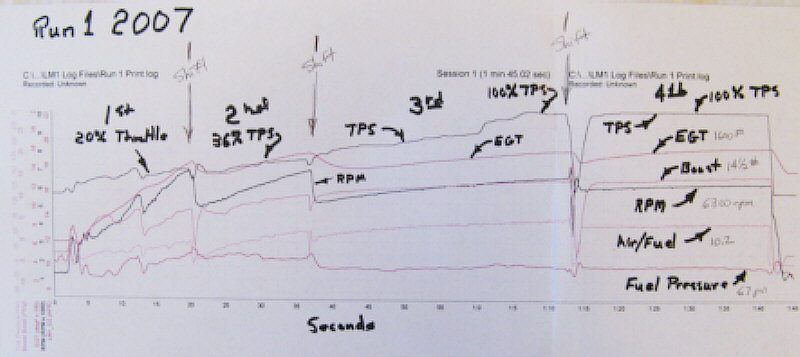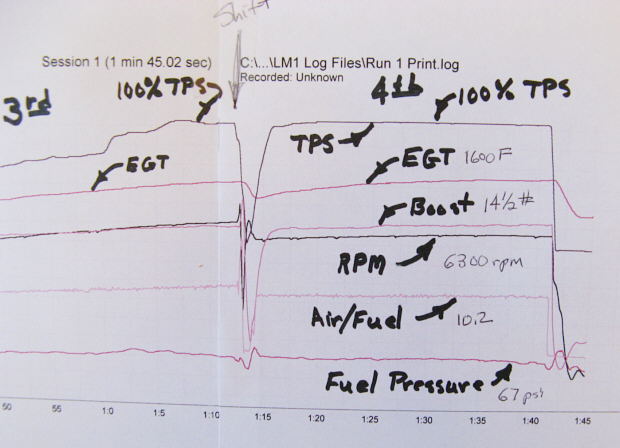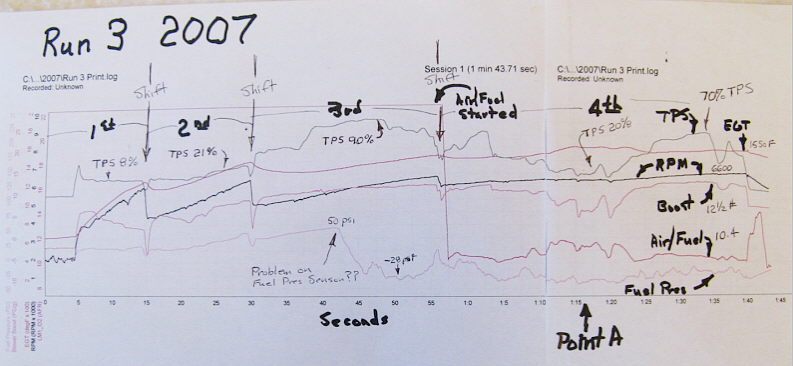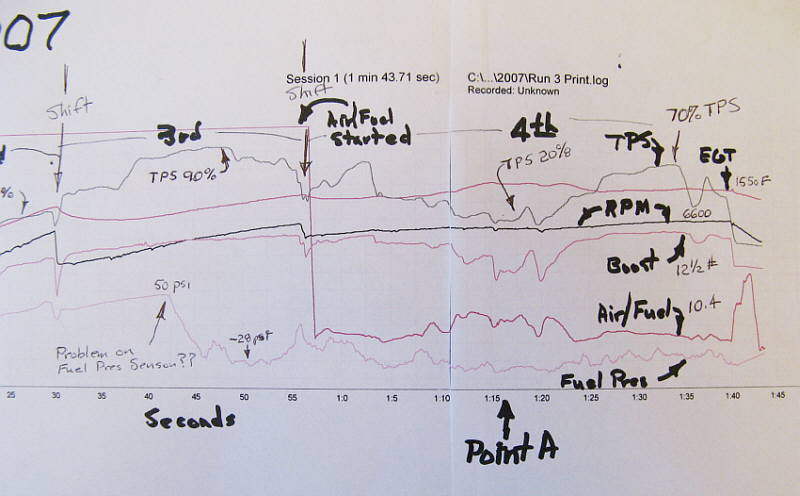................................................Return to Sumner's Home Page
.......Return To Mine & Other Bonneville Car Construction Pages
.............................................Return to Hooley's Index Page
...............................................................................2007 Data Logs
Here I'll try and explain how I interpret our data from the runs. Notice I said "I" as I have no training in this and I'm open to any suggestions you might have,
Sum................
This is run 1 where we forgot to turn the water pump on and the temp (on the water temp gauge that we video) went way up before the car was even in 2nd. This probably caused it to loose power as at the end of the run there was water coming out the exhaust and we severely warped the heads ( STORY HERE). Notice that Hooley is only able to use 20 % throttle in 1st and 36% in 2nd. By the end of 3rd he is at 100% and was able to run 100% thru 4th. Believe me he uses all he can without getting wheel spin the entire run. Notice the dips in the TPS data in 1st as the car gets loose and he has to back out of the data. This was Sat. and the track was pretty good. Compare this to the run below later in the week on Thursday.
...............
Here is a close-up of the end of 3rd gear and all of 4th until he gets to the 5 mile and shuts it off. 100% throttle, the EGT was higher than it ever has been by about 50 degrees (most likely due to the heat in the motor from no water circulation), rpm was about 6300 (232 mph) at the end of the run (also note the 3-4 shift and that we only loose about 500 rpm with the 7% over-drive 4th gear), the air/fuel ration was 10.2 to 1 -- very fat, but we think we need it this fat to help cool the motor on blown gas, fuel pressure was 67 psi (we don't really have a handle on this data yet). Note that with 100% throttle most of these are nice smooth curves compared to the run below.
Just looking at this data you wouldn't know the motor got hurt, but look how it was laboring producing 14 lbs of boost and running at full throttle to get to 232 mph.
...............
After the 1st run and the warped heads it took us basically to the next Thursday before we were ready to run again. During this period the track got a lot of use and deteriorated, at least in our view (both runs were on "course 1" that ran past the pits). Notice now that Hooley was only able to use 8% throttle in 1st (again notice the dips in the rpm line as he looses traction). In 2nd he was up to 21% throttle. In 3rd (1 to 1 in the transmission) he managed a high of 90% for a short period and was never able to get there again. Notice the rise in the throttle after the 3-4 shift and just over a minute into the run he has to back off the throttle, but still the rpm climbed, just not as fast as if the track would have been better. He dropped as low as 20% throttle and then was able to climb back up to 70%. On this run with less throttle though he ran a 238 mph 5th mile to qualify us 2 mph over our record from 2006 and his exit speed was 243, eleven mph faster than the first run above.
......... ......
......
Here is the same run from the 2-3 shift until the end of the 5th mile in more detail. Some funny stuff happened with our data here. One is the air/fuel did not start recording to about the 57 sec. mark. I think it might have fallen out and the sensor was re-warming up, but I'm not sure. Also at the 42 second mark the fuel pressure dropped from 50 psi way down to the point it was actually giving negative numbers for the rest of the run. I know that is not possible since the air/fuel once it kicked in looked normal so I'll only look at the trend of the fuel pressure from the 42 sec. point on. I do think we have to work on the part throttle fuel situation though.
Look at what is happening at "Point A" (1 min 17 sec.). Hooley had to get out of the throttle and it dropped to about 20% throttle, the boost went down (normal), but also since the barrel valve was closed more we were probably off the "pill more" (Enderle Mech. Fuel Injection) and on the intermediate ramp opening in the barrel valve and not putting out enough fuel. The fuel pressure dropped during this period and the air/fuel rose into the high 11's to 1 ratio where we don't want it. Notice the EGT rising during this period and then as he was able to pick up the throttle the boost rose, fuel pressure rose, air/fuel got richer, and the EGT dipped back down.
Since the motor was not pumping water out the exhaust and loosing power we actually made more power with less throttle, less boost (12 lbs vs. 14+ lbs) and went 11 miles an hour faster. So some of his running less throttle besides the track conditions might have been he was making more HP and it was easier to spin the tires. Still the track was a real handful. Watch the video below and see how he was all over the place compared to his first run. He almost pulled the chute a couple time he said. Then look at Friday's run. We will add more weight to the car for next year. It should help us to accelerate faster by using more HP in the lower gears and help to make the car more stable and also help to get the HP to the ground at top speed. I think with more weight and a better track the car will run 250-255 mph the way it is now.
Thursday's record qualifying run of 238 mph (Run 3 above):
http://www.youtube.com/v/uSrGmZC2M1M
Friday's aborted backup run with a spin at about 225 to 230 mph:
http://www.youtube.com/v/VyWUfWaWEDQ
............................................................Return to Hooley's Index Page